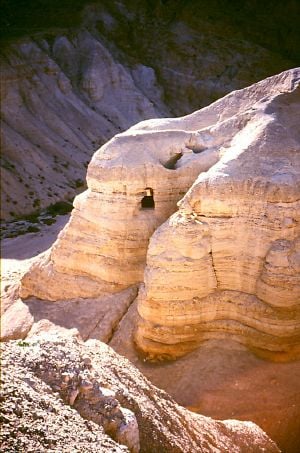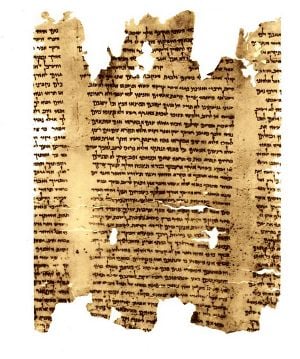Difference between revisions of "Damascus Document" - New World Encyclopedia
m (→Body Text) |
m |
||
| Line 29: | Line 29: | ||
On the other hand, some scholars have argued that the Dead Sea Scrolls are not related to the supposed Essene community at Qumran. In these theory they form a depository of texts probably originating in Jerusalem, and were placed in Qumran for safe keeping when the Romans destroyed the Temple in 70 C.E. | On the other hand, some scholars have argued that the Dead Sea Scrolls are not related to the supposed Essene community at Qumran. In these theory they form a depository of texts probably originating in Jerusalem, and were placed in Qumran for safe keeping when the Romans destroyed the Temple in 70 C.E. | ||
| − | |||
| − | |||
| − | |||
| − | |||
| − | |||
| − | |||
| − | |||
== References == | == References == | ||
Revision as of 01:57, 31 May 2008

The Damascus Document, also called the Zadokite Fragments, one of the works found in multiple fragments and copies in the caves at Qumran, and as such is counted among the Dead Sea Scrolls. The current majority view among scholars is that the scrolls are related to an Essene community based there around the first century B.C.E. Because it gives specific insights into the unique religious attitudes of its writers, the Damascus Document is considered one of the most important sources for understanding the ancient Essene movement.
Historians believe that some of the Essenes isolated themselves in the wilderness near Qumran during the reign of Antiochus IV Epiphanes beginning around 175 B.C.E., in order to escape persecution.
The Damascus Document seems to have been written in stages between that time and 70 C.E., when the Essen community at Qumran community at Qumran was abandoned.
The first section of the Damascus Document consists concerns the community's religious teachings. It stresses devotion to Israel's covenant with God and an absolutely strict interpretation of Jewish Sabbath laws and other injunctions. The document also speaks of a Teacher of Righteousness, who is opposed by the Wicked Priest. Various theories have emerged concerning the identity and roles of these two antagonists. The document predicts that the age of the Messiah would begin 40 years after the Teacher death.
The Damascus Document's second section contains a set of regulations concerning community life and discipline that gives a sense of the Qumran sect's way of life as they prepared themselves for the Messiah's coming.
History
The title of the document comes from numerous references within it to Damascus. It is a matter of debate whether this is a literal reference to Damascus in Syria, or a metaphorical references to a great pagan city (as "Babylon" is in the Book of Revelation), or possibly even Qumran itself. Damascus had supposedly been part of Israel under King David, and the Damascus Document expresses an apocalyptic hope of the restoration of a Davidic monarchy.
The document prominently mentions a Teacher of Righteousness, whom some of the Qumran scrolls treat as a figure from their past, and others treat as a figure in their present, and still others as a figure of the future. The document describes the group among whom the it was created as having been leaderless for 20 years before the Teacher established his rule over the group. This too is a subject of much debate, but historians generally date the Teacher to circa 150 B.C.E., largely due to the fact that the document states that he arrived 390 years after the Babylonian Exile.
Even before the Qumran discovery of the mid-twentieth century, parts of this work had been known to scholars, through two manuscripts found during the late nineteenth century among the Cairo Genizah collection. These fragments are known as the "CD" ("Cairo Damascus") documents and date from the tenth and twelfth centuries. In contrast to the fragments found at Qumran, the CD documents are largely complete, and therefore are vital for reconstructing the text.
Eight separate copies of the Damascus Document were kept in Qumran Cave 4 and an additional copy in Cave 5. These have been dated to the beginning of the Common Era, give or take several decades. Where the content of the Qumran fragments overlaps with Geniza manuscripts there is little variation between them.
The relationship between the Damascus Document and the Community Rule remains a matter of controversy, although the two documents clearly share a great deal of sectarian terminology.
The Geniza versions begin with an exhortation speaks of the origins of the Essene movement.
"The Community Rule" is this work's own title in one manuscript. It has also been called the "Manual of Discipline." The Community Rule describes a community similar to the Essenes as portrayed by historians such as Josephus and Philo. Like the Essenes, the Community Rule insisted on community ownership of property and provides rules for joining the community that are likewise similar to other descriptions of the Essenes. It speaks of a ceremonial meal to be shared only by ritually pure members and prescribes an oath to be taken by new members. It also seems to hold that only celibate men may become full members of the sect.
On the other hand, some scholars have argued that the Dead Sea Scrolls are not related to the supposed Essene community at Qumran. In these theory they form a depository of texts probably originating in Jerusalem, and were placed in Qumran for safe keeping when the Romans destroyed the Temple in 70 C.E.
ReferencesISBN links support NWE through referral fees
- Broshi, Magen: The Damascus document reconsidered (Israel Exploration Society: Shrine of the Book, Israel Museum, 1992)
- Davies, P. R.: The Damascus covenant: an interpretation of the "Damascus document" (Sheffield, 1983)
- Ginzberg, L.: An Unknown Jewish Sect (E.T.: New York, 1976)
- Kahle, Paul: The Cairo Genizah (Oxford: Blackwell, 1959)
- Rabin, C.: The Zadokite documents, 1: the admonition, 2: the laws (2nd ed. Oxford, 1958)
- Reif, Stefan: Article "Cairo Genizah," in Encyclopaedia of the Dead Sea Scrolls (Oxford: OUP: forthcoming 1997) ed LH Schiffman and JC VanderKam
- Rowley, H. H.: The Zadokite fragments and the Dead Sea scrolls (Oxford: Blackwell, 1952)
- Schechter, S.: Documents of Jewish sectaries/ edited from Hebrew MSS. in the Cairo Genizah collection, now in the possession of the University Library, Cambridge (Cambridge: University Press, 1910) 2 v
- Zeitlin, Solomon: The Zadokite fragments: facsimile of the manuscripts in the Cairo Genizah collection in the possession of the University Library, Cambridge, England (Philadelphia: Dropsie College, 1952)
Credits
New World Encyclopedia writers and editors rewrote and completed the Wikipedia article in accordance with New World Encyclopedia standards. This article abides by terms of the Creative Commons CC-by-sa 3.0 License (CC-by-sa), which may be used and disseminated with proper attribution. Credit is due under the terms of this license that can reference both the New World Encyclopedia contributors and the selfless volunteer contributors of the Wikimedia Foundation. To cite this article click here for a list of acceptable citing formats.The history of earlier contributions by wikipedians is accessible to researchers here:
The history of this article since it was imported to New World Encyclopedia:
Note: Some restrictions may apply to use of individual images which are separately licensed.
